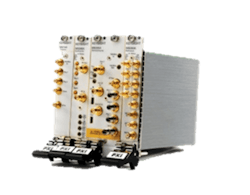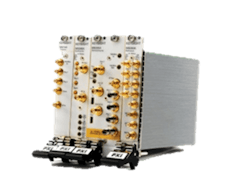MIL/aero test: driving toward a culture of affordability
A move to a culture of affordability is a key trend in the military/aerospace test arena, according to Andrew Smail, product and solutions marketing manager, Software & Modular Solutions Division, Keysight Technologies. “Mil/Aero organizations are embarking on an industry-wide program to promote affordability in their products and among customers and suppliers,” he said. “It’s a massive undertaking that will require the industry to change its culture to one in which exquisite technologies and affordability are uttered in the same breath.”
Modularity—in proprietary or open-architecture form factor—offers one path to affordability. “Keysight has switch/measure products based on proprietary backplanes (including 34970A, 34972A, and 34980A) that provide very cost-effective point solutions,” Smail said. But Keysight also offers an extensive line of open-architecture PXI, PXIe, and AXIe products, as described in this month’s Test Applications Special Report.
According to Mike Dewey, director of marketing at Marvin Test Solutions, “MTS is committed to using established (industry-standard) modular architectures and does not recommend proprietary solutions.” He added, “It’s very clear that modular architectures provide the flexibility to adapt to changing/evolving test needs. We find this particularly true with digital instrumentation and more specifically, with user-programmable FPGA products. FPGA-based products provide multiple levels of flexibility.
“The user can reprogram the FPGA as his/her needs evolve and if at some point, more performance is needed, the module can be swapped out with a higher performance product with the FPGA code being re-hosted on the higher performance module. Similarly, we are seeing this flexibility with RF instrumentation, where the user can swap out RF modules as test needs evolve.”
MTS does not offer AXIe products. “MTS believes that PXI and PXIe maximize the customer’s advantages pertaining to performance, footprint, and value, and therefore only focuses on these architectures,” Dewey said.
Reggie Rector, senior product manager for automated test at National Instruments, elaborated on PXI. “The PXI standard is almost 20 years old, and with over 1,500 modules available and over 50 vendors innovating on the technology, PXI will continue to strengthen its position atop the modular instruments leaderboard over the next decade,” he said. “The major advantage of any architecture is the quality and longevity of the software stack that sits atop it. PXI utilizes both plug-and-play instrument drivers as well as IVI Class drivers to ensure efficient development and software stack stability.”
Of course, adopting a modular architecture does not preclude the use of rack-and-stack instruments. “There are a few key benefits that PXI provides when developing a ‘mixed’ ATE system,” Rector said. “The first is communication. PXI offers numerous ways to communicate to non-PXI instruments over standard buses and networks such as RS-232/485, GPIB, or LAN. The second is synchronization. While instruments inside the PXI chassis can be tightly synchronized to develop, for example, phase-coherent MIMO systems, users can also share reference clocks (for example, 10 MHz) from a PXI system to the non-PXI system to create a highly synchronized ‘mixed’ ATE system.”
The third benefit is data transfer. “While most boxed instruments are limited in data movement due to vendor-defined data decimation and low-bandwidth buses, there are cases where a non-PXI system has the capacity to transfer at PCIe speeds, such as an FPGA farm,” Rector said. “In these cases, engineers can get 2 to 3+ GB/s between PXI and the non-PXI system using PXImc [PXI MultiComputing] technology or high-speed serial instruments.”
Retaining PCI and GPIB support
David Owen, business development manager at Pickering Interfaces, said his company supports PXI, PCI, and a modular proprietary LXI architecture. “PCI is commonly used in cost-sensitive applications,” he said. “PXI is one of the best platforms for the broadest range of applications, and LXI switching tends to address higher I/O applications.” Modular instruments, he said, allow users to change the content of switching systems at finer levels of granularity than do larger bench switching systems.
Pickering provides software drivers for all its modular products, Owen said, which work with all major programming languages. The drivers are IVI-compliant, he said, which is important with some switch-management environments.
Owen added, “Pickering has a proprietary modular product family based around GPIB communication, but we only promote this for legacy applications as the family was designed over 25 years ago. Military organizations around the world expect product support for a long, long time—hence our ongoing sales of GPIB switching.”
Application software
Software is also part of the move to a culture of affordability. “Keysight provides application software that can be used with its traditional benchtop instruments, as well as its modular instruments,” Smail said. “This ensures measurement consistency and a common user experience regardless of instrument form factor selected.” Keysight’s software applications supported on modular instrument systems include
- Signal Studio,
- Waveform Creator,
- 89600 VSA software, and
- X-Series measurement applications.
In addition, Smail said, “Keysight’s philosophy is to support software platforms most commonly used by its customers,” including the following third-party software applications:
- MathWorks MATLAB and
- NI LabVIEW
Dewey commented on MTS’s software strategy. “We offer a wide range of software products that can be used with both Windows and Linux,” he said. “Additionally, we offer a full-featured test-executive/test-development software suite—ATEasy. The open architecture of modular instrumentation requires that we support a range of application development environments including C, LabWindows, LabView, and .NET. We also offer a variety of specialized software tools for supporting the development of digital and analog tests as well as offering digital vector translation tools for LASAR, WGL, VCD, STIL, etc.”
Rector at NI said, “The demand on automated test software has increased rapidly over the last decade due to the need for highly customizable, flexible, and capable measurement systems. The trend toward increased product complexity and capability has made a direct impact on test software and the importance of test system reliability, performance, and accuracy. This, in turn, has prompted an increased focus on ensuring the quality and reliability of test software through life-cycle management and development practices formerly reserved for embedded systems. Some organizations are voluntarily applying these development practices to improve test software and build more feature-rich and defect-free test solutions, but a growing number of industries will be required to use similar practices to comply with regulatory standards.”
NI offers support for more than 2,000 different instruments through its Instrument Driver Network, Rector said. He added, “Products developed for regulated industries such as automotive, aerospace, and medical must comply with rigorous development standards and certifications. NI software is developed with these needs in mind, with special attention being paid to backwards compatibility, scalability, and facilitating rapid learning cycles. This development philosophy extends all the way from our instrument drivers for the wide range of modular PXI instruments to application software such as LabVIEW, LabWindows/CVI, and TestStand.”
See these related articles:
- Capitol Hill offers hope for MIL/aero industry
- Pickering Interfaces introduces PCI fault-insertion card
- Two-port 26.5-GHz vector network analyzer fits in one PXI slot
- GENASYS platform advances mission-critical aerospace production test
- Embracing LXI and PXI for Switching
- NI debuts Xeon-Based PXI controller and high-bandwidth chassis
- Peak Group to add to PXI ATE portfolio
And visit our military/aerospace technology page here.
About the Author

Rick Nelson
Contributing Editor
Rick is currently Contributing Technical Editor. He was Executive Editor for EE in 2011-2018. Previously he served on several publications, including EDN and Vision Systems Design, and has received awards for signed editorials from the American Society of Business Publication Editors. He began as a design engineer at General Electric and Litton Industries and earned a BSEE degree from Penn State.

